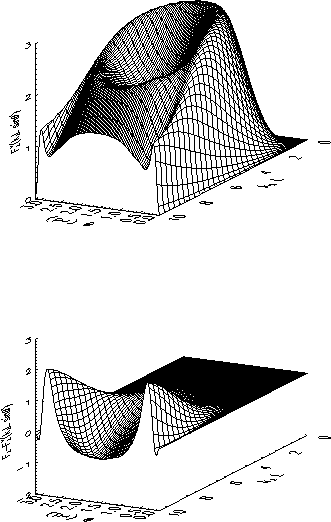To compute the Doppler effect on the voltage power spectrum seen by the antenna,
we have to substitute in (1)
the electric field ![]() with
with
![]() , where
, where ![]() is the relative
velocity of the antenna with respect to the ambient plasma.
is the relative
velocity of the antenna with respect to the ambient plasma.
Since ![]() is roughly perpendicular to
is roughly perpendicular to ![]() and
the angle between the spin plane of the antenna and the plane defined by
and
the angle between the spin plane of the antenna and the plane defined by
![]() remains small (
remains small ( ![]() ), we may write
), we may write
![]() .
The solution
.
The solution ![]() of the dispersion equation in the presence of the relative
velocity will thus be modified from the nonshifted solution
of the dispersion equation in the presence of the relative
velocity will thus be modified from the nonshifted solution ![]() , as
, as
![]() with
with ![]() ,
which reads
,
which reads
![]()
where we have set ![]() .
Now if we replace
.
Now if we replace ![]() in (1) with
in (1) with ![]() , we obtain a
Doppler-corrected antenna response function:
, we obtain a
Doppler-corrected antenna response function:

We may remark that ![]() is an even function of
is an even function of
![]() with
with ![]() , so that
, so that
![]() .
However, this factor
.
However, this factor ![]() could take values close to 1, especially near the gyroharmonics where
could take values close to 1, especially near the gyroharmonics where
![]() , and so
we have numerically studied the variation of the function
, and so
we have numerically studied the variation of the function ![]() with the variations of the plasma parameters involved in (A2).
with the variations of the plasma parameters involved in (A2).
During the IPT crossing, at a Jovicentric distance of about 8 ![]() ,
V is nearly the corotation velocity
[Stone et al., 1992b], which increases with the Jovicentric
distance
,
V is nearly the corotation velocity
[Stone et al., 1992b], which increases with the Jovicentric
distance ![]() from
from ![]() to
to ![]() km/s and the temperature
from
km/s and the temperature
from ![]() near the torus equator to
near the torus equator to ![]() at
highest latitudes. These variations lead to a parameter a such that
0.05<a<0.1, and the derivative
at
highest latitudes. These variations lead to a parameter a such that
0.05<a<0.1, and the derivative ![]() can be computed using (B3). This
derivative depends on the gyroradius, that is, on both the temperature and
the gyrofrequency
can be computed using (B3). This
derivative depends on the gyroradius, that is, on both the temperature and
the gyrofrequency ![]() which decreases with
which decreases with ![]() from
from ![]() to
to
![]() kHz. All these variations cannot be easily summarized and have to
be computed for each spectrum. The result is that the difference between the
Doppler-affected modulation
kHz. All these variations cannot be easily summarized and have to
be computed for each spectrum. The result is that the difference between the
Doppler-affected modulation ![]() and
the modulation given by (2)
does not exceed in any cases
and
the modulation given by (2)
does not exceed in any cases ![]() for
for ![]() We show in Figure A1 a typical sample of the antenna response
with Doppler
effect computed from (A2), with a= 0.06 and
We show in Figure A1 a typical sample of the antenna response
with Doppler
effect computed from (A2), with a= 0.06 and ![]() .
.

Figure A1: (top) Antenna response to Bernstein waves with Doppler effect
and (bottom) the difference with the antenna response without Doppler effect
shown in Figure 3
as a function of kL and the angle ![]() between the antenna and
the magnetic field (in radians).
between the antenna and
the magnetic field (in radians).